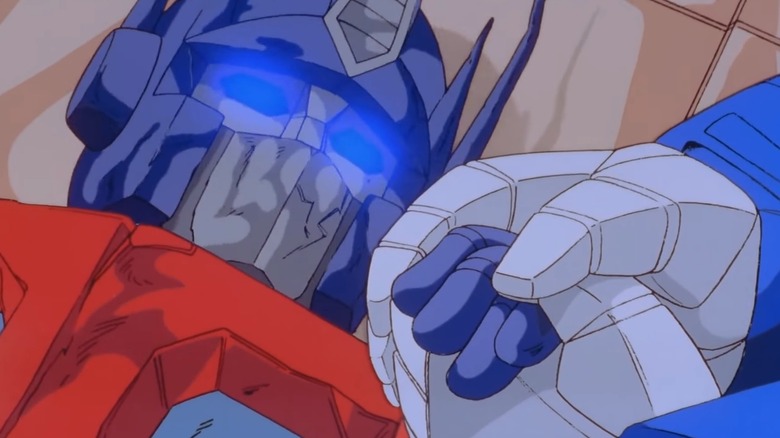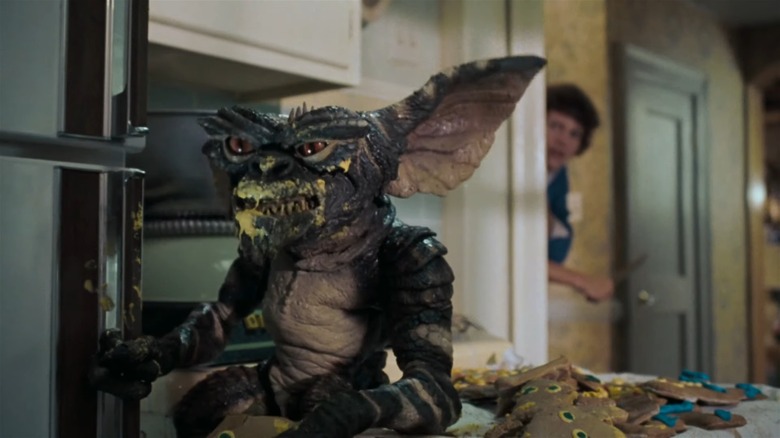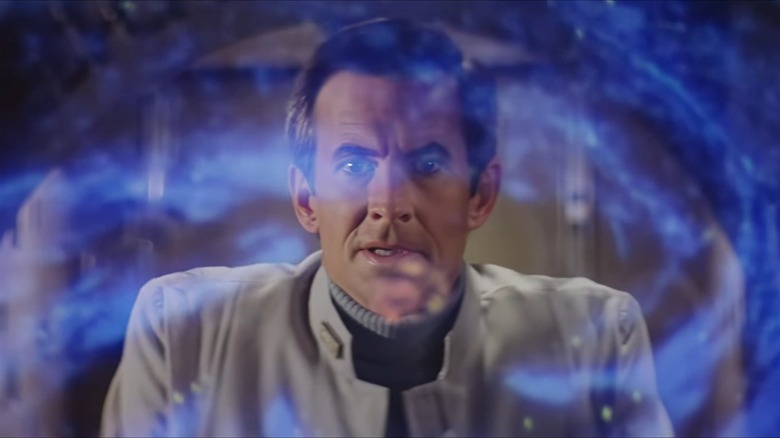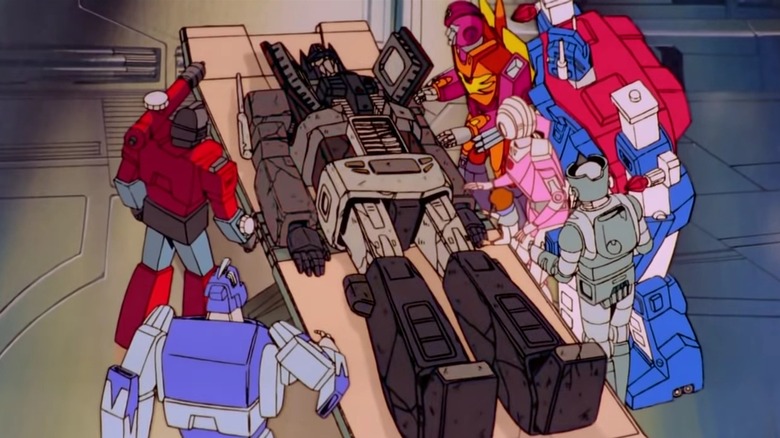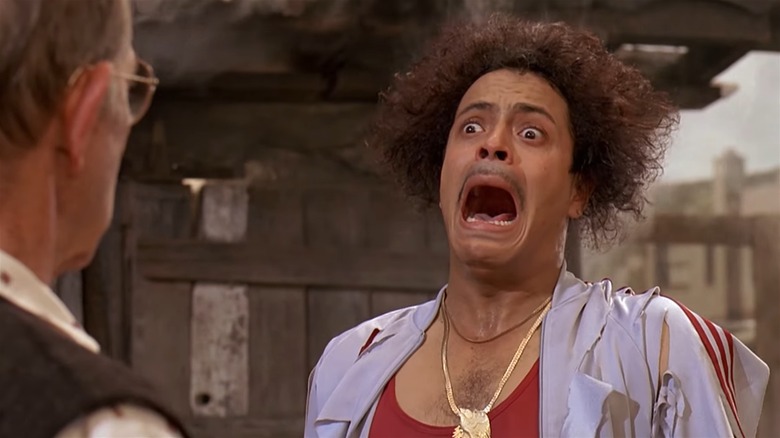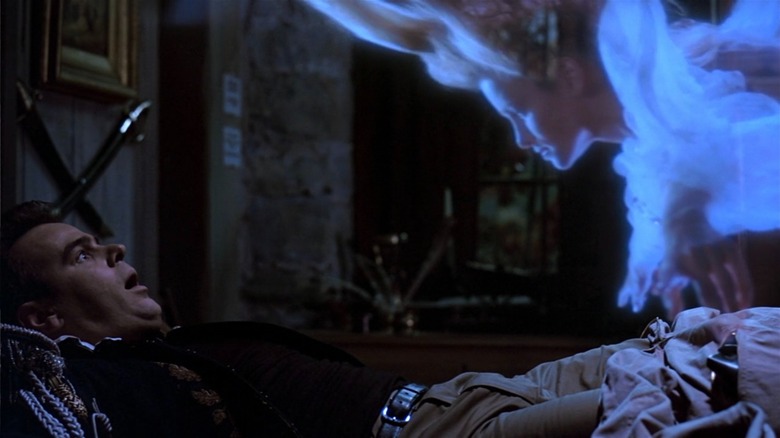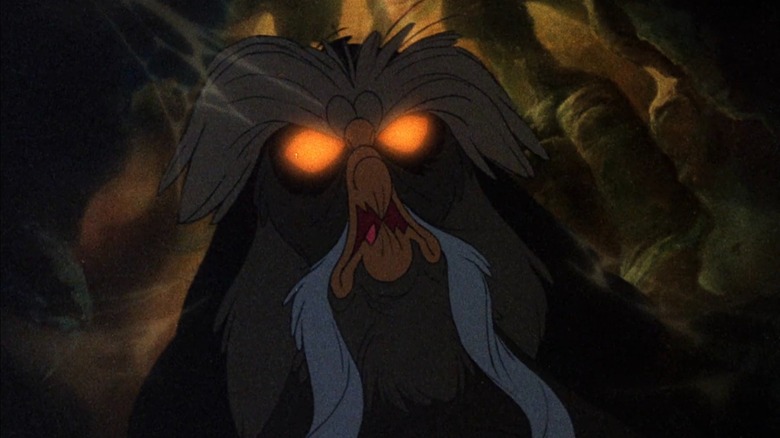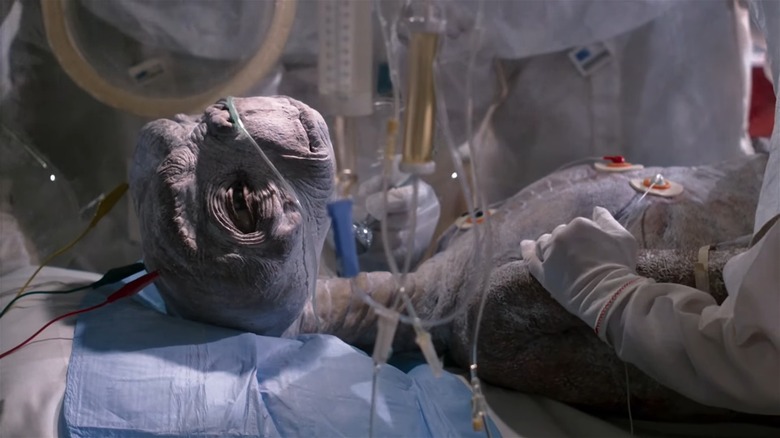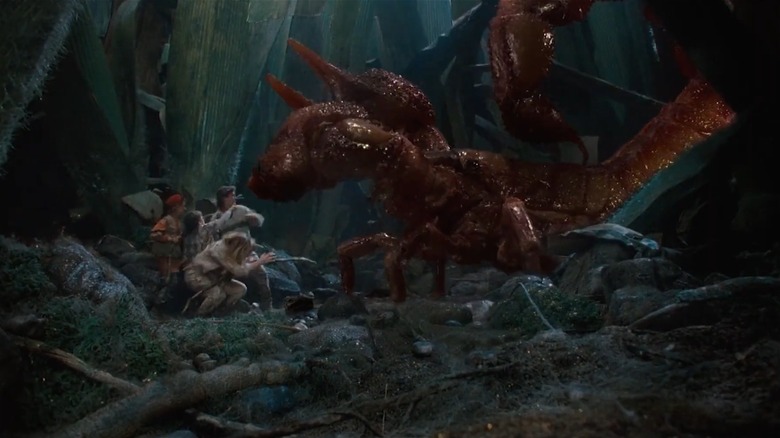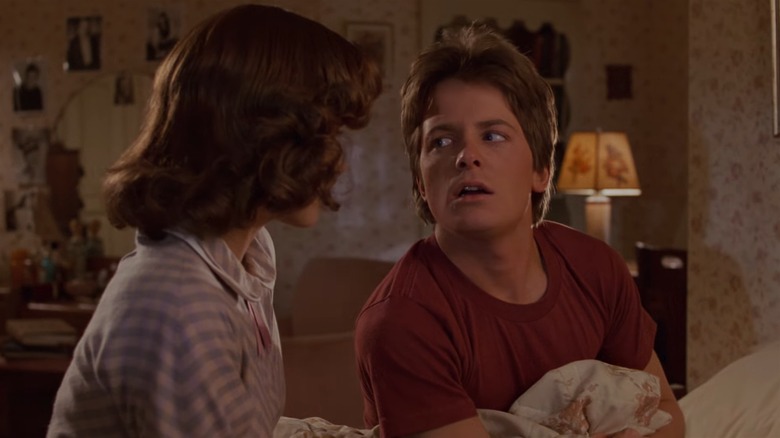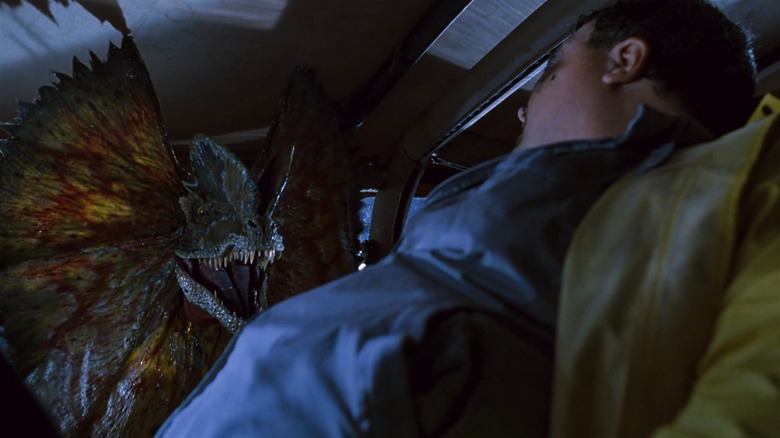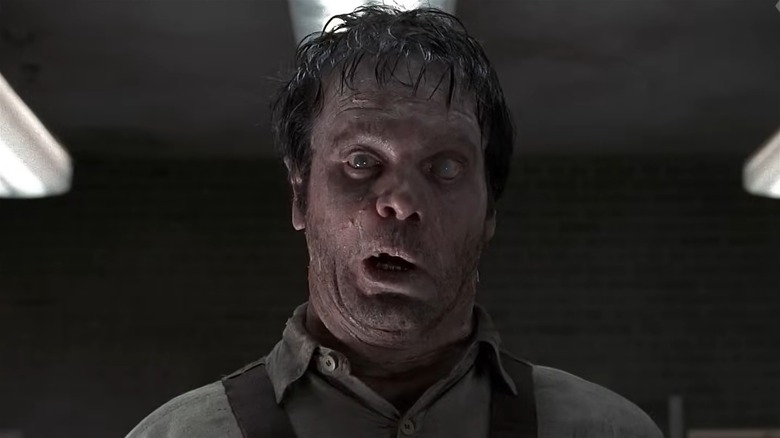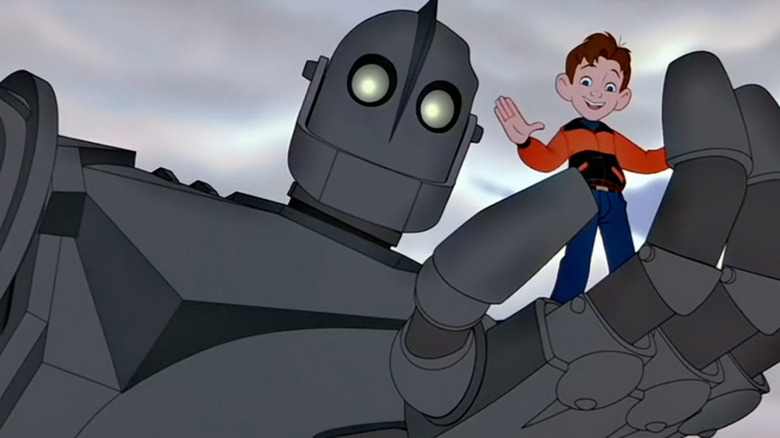Family Sci-Fi Movies That Went Too Far For Kids
We're in an interesting cultural moment. For a while, it seemed like society was becoming more progressive, and the film industry seemed to follow suit; there are more stories being told now, about more kinds of people. However, if you take a cursory look at Film Twitter or FilmTok, you're likely to find people complaining about "unnecessary sex scenes." There's a backlash brewing, a sense that movies need to get back to an imagined past when everything was about plot.
A lot of that concern involves kids, as if the two kinds of entertainment are either "Oppenheimer" or "Bluey." In fact, there's a lot of middle ground, and there used to be even more. Especially in the 1980s and 1990s, a lot of family-friendly films included scenes for adults that felt a bit out of place but made it in anyway. These days, a lot of those violent, strange edges would have been sanded down by studios. Once upon a time, though, you could slip something genuinely upsetting into a movie otherwise appropriate for kids.
That's how we learn and grow, right? The films on this list are all family-friendly sci-fi movies that some might say went too far for kids, but they're also films that have stuck in the cultural memory, films that came along for certain people at a formative time and gave us a peek into the scary world of grown-ups.
Kate's Christmas story in Gremlins is haunting
In Joe Dante's "Gremlins," Billy (Zach Galligan) receives a strange Christmas gift from his father. The present is a Mogwai called Gizmo: a tiny, furry creature with big ears, a friendly disposition, and a simple list of rules for care. Billy, of course, breaks the rules, albeit accidentally — he feeds Gizmo after midnight and gets him wet — and soon the house is overrun with evil, demented, scaly green Gremlins instead.
Even though the movie occasionally turns violent — and "Gremlins" was originally far more gruesome – it's still mostly fine for kids. The Mogwai are adorable, even when they mutate and are meant to be a bit scary. For example, kids will enjoy the gross-out thrill that comes with seeing a Gremlin get blown up in a microwave. It's the little things in life.
There's one scene in "Gremlins" that crosses the line, however. Billy has a crush on Kate (Phoebe Cates), and at one point she tells him why she hates Christmas. When she was little, Kate's father dressed up as Santa, planning to climb down their chimney and surprise his kids on Christmas morning. He got stuck, and the family didn't even know he'd died up there until the smell became impossible to ignore. It's so jarring, so upsetting, so tonally out of place with the rest of the movie that "Gremlins 2" spoofs it, cutting Kate off before she can finish explaining why she hates President's Day. It's a relief!
The Black Hole sends audiences on a psychedelic trip to Hell
1979's "The Black Hole" opens with a spaceship coming upon a lost vessel, frozen at the edge of a black hole. As they look at a hologram of the swirling mass of energy and darkness, Harry (Ernest Borgnine) mutters, "My God ... Right out of Dante's 'Inferno.'" He's more correct than he knows.
Even though this is a PG Disney movie, not much about "The Black Hole" will work for kids. It's a strange, slow, talky film, one that depends on actors like Anthony Perkins, Yvette Mimieux, and Robert Forster to give it gravitas. Sure, there's a cute droid named V.I.N.C.E.N.T., a googly-eyed fellow who looks designed to sell toys, but V.I.N.C.E.N.T. is out of place in a story that mostly consists of characters ruminating on the nature of the cosmos.
When the action picks up, "The Black Hole" gets downright experimental. It's like "Star Wars" by way of "2001: A Space Odyssey," its narrative almost entirely subsiding in favor of trippy visuals with metaphorical implications. The movie looks fantastic, even now, thanks to its reliance on practical effects mixed with very (very) early CGI, and those bizarre visuals turn terrifying. In the movie's final act — as the crew clashes with the captain of the lost vessel, the black hole drawing them ever nearer — Harry's remark comes true. Inside the black hole lurks a hellish oblivion, becoming a descent into an inferno much too haunting for kids.
The Transformers: The Movie traumatized '80s kids
"The Transformers: The Movie" is set in the then-futuristic year of 2005, but the movie is all '80s. From the hair metal soundtrack to the voice cast full of folks like Leonard Nimoy and Judd Nelson, it's understandable that '80s kids would have been hyped for a movie featuring their favorite toy robots.
Unfortunately, those '80s kids were instead utterly horrified to see legendary Autobot leader Optimus Prime get killed off in the movie's opening act. He dies a disturbing death during an assault on Autobot City, passing along the power of the Matrix moments before flatlining and turning grey. Imagine Mufasa's death at the beginning of "The Lion King," except if kids had spent years playing with Mufasa action figures after falling in love with his adventures on a Saturday morning cartoon. Goodbye, Optimus Prime; hello, all-new cast of characters. What better way to sell more toys!
Understandably, audiences were not happy. Voice actor Peter Cullen told Collider that the outcry was so great, the character was resurrected for a short run of TV episodes. "A lot of kids evidently had trouble with that scene, and they were not coming out of their rooms and hiding under beds, I was told," he recalled. "So they brought me back for three shows. The mothers of America went to the powers that be, and so they had to bring me back."
Kids will have questions about *batteries not included
In the first few minutes of the Steven Spielberg-produced "*batteries not included," a character walks past graffiti reading, "For A Good B*** J**..." Moments later, there's a wall-sized, "Buck You, Gasshole." We meet a pregnant woman named Maria (Elizabeth Peña) as she enters her apartment, walking through a leering group of men who grope her as she passes. Yikes.
In other words, "*batteries not included" isn't nearly as kid-friendly as its PG rating suggests. It's about a group of residents who band together to stop an evil landlord from razing their building. To that end, they rely on a duo of benevolent, flying, alien-robots who can repair broken things. Mostly, the movie is charming, but every now and then it dips into blue humor sure to prompt questions from kids. One night, the two aliens perform a mating dance and then get their rooftop shed rockin' and rollin', prompting one character to ask, "What are they doing?" An elderly woman named Faye (Jessica Tandy) grins, "Can't you tell?" Parents may have to give their kids a talk when the robot gives birth a few minutes later.
To be clear, all of this makes for a more interesting movie, as it's quite fun to see the mash-up of Spielbergian, kid-friendly alien stuff with more grown-up themes about the solidarity of the working class. The fully-nude painting of the pregnant lady, though, might be too much for younger audiences.
The original Ghostbusters features ghost sex
The modern "Ghostbusters" movies feature a cast of kids like McKenna Grace and Finn Wolfhard. They're family stories now, movies about precocious youngsters teaming up with some older folks to hunt ghosts. It's easy to forget, then, that the original "Ghostbusters" starred a bunch of guys from "Saturday Night Live," and its humor reflected that late-night sensibility, even as Ivan Reitman rewrote the rules of genre cinema.
During the iconic mid-movie montage set to that iconic theme song, Dan Aykroyd proves that he ain't afraid of no ghosts... after all, he dreams about receiving oral sex from one. He opens his eyes to find a beautiful lady ghost hovering over his midsection; his belt and zipper undo themselves, and then we're treated to a closeup of Aykroyd's eyes crossing. This sequence is actually all that remained of a longer subplot (with footage once thought to be lost) where Aykroyd's character actually fell in love with a ghost.
Aykroyd himself defended the ghost sex for a different reason: he claimed it was realistic! "The ghost in the fort — the seduction ghost — in paranormal research that's a common thing, ghosts doing sexual things to people," Aykyrod insisted. "I have a friend who had three women visit him in a haunted house in Louisiana, and it was one of the greatest nights of his life." Well there you have it, folks: "Ghostbusters" is a paragon of realism.
The Secret of NIMH's animation is unforgettable
"Jonathan Brisby was killed today while helping with the plan." That's how Don Bluth's 1982 film "The Secret of NIMH" opens, signaling that this isn't your average cartoon. Bluth, who worked on Disney films like "Pete's Dragon," led a walkout of Disney animators to open his own production studio. This eventually led to films like "The Land Before Time" and "All Dogs Go To Heaven," but "The Secret of NIMH" was Bluth's first outing as director. What an outing it is.
Masterfully blending talking-animal fantasy with science fiction elements, "The Secret of NIMH" follows a mouse named Mrs. Brisby, bereaved wife of Jonathan. Her son is deathly ill and there are rumors in the yard that their habitat will be razed, so Mrs. Brisby goes on a journey to the rats of NIMH for help. It's full of very adult themes — grief over the loss of a partner, mortal terror at the sickness of a child — told through gorgeous, unforgettable animation.
In fact, that's where "The Secret of NIMH" becomes too much for some kids to handle. Before I read "Mrs. Frisby and the Rats of NIMH" as a kid, a friend told me the movie was terrifying. Sure enough, when Mrs. Brisby meets The Great Owl, the bird and its glowing eyes are downright fearsome. Bluth's later movies are great too, but this one especially stands as a testament to his willingness to push the envelope of dark children's entertainment.
The scene where E.T. gets sick is the stuff of nightmares
As a kid, I was sick a lot. I had bad asthma, and shortly after I turned seven, I was hospitalized with what my doctor said was the worst case of the flu he'd ever seen. As a result, I grew up with a lot of medical anxiety, and that one scene in "E.T.: The Extra-Terrestrial" — where Elliott (Henry Thomas) and E.T. are quarantined by the government — sure didn't help!
At that point, we've spent the first two acts watching as the boy and his alien experience a deepening psychological bond. It's a psychic, empathetic connection that lets them feel one another's emotions. The government, though, has been hot on E.T.'s trail, and in the final act, they catch up. A weakened, greying, desiccated E.T. is rushed into quarantine, and Elliott's own health declines as his friend fades away.
It's horrifying, which makes sense since the original "E.T." was meant to be a horror movie. The comforting suburbia of the rest of the film is traded for sterile environments full of medical equipment, faceless government bureaucrats, and frightening, beeping machines. E.T. is adorable, so it's upsetting for kids to see him like this. Thomas is great too, especially for such a young actor, because he sells Elliott's increasing desperation as his friend dies. Thankfully, after he flatlines, E.T. recovers, but the trauma is still there.
The scorpion in Honey, I Shrunk the Kids is intense
In "Honey, I Shrunk The Kids," Rick Moranis plays Wayne Szalinski, a klutzy inventor who mostly just annoys his family with a bunch of blasted contraptions that never seem to work the way they're supposed to. One day, though, he invents a shrinking ray that works exactly as it's supposed to ... almost too well. After an incident involving a wayward baseball, Szalinski's kids and neighbors are reduced to the size of Cheerios. When they're accidentally swept up and taken out with the trash, they must journey across a treacherous backyard in order to get back home.
For the most part, "Honey, I Shrunk The Kids" is good, wholesome family fun. Moranis is playing a deeply silly character, something he does particularly well. The kids are great too. Even though there's some childish bickering, it's mostly charming rather than off-putting.
There's one sequence, however, where the movie tips from "adventure" into "creature horror." The kids befriend a young ant, but at night they are attacked by a scorpion. Through excellent use of miniatures, the resulting action is intense, featuring frame-filling shots of whirling mandibles bearing down on the camera. The scorpion looks genuinely grotesque up close, its exoskeleton covered fleshy bits, and it winds up mortally wounding their ant friend. This scene is undoubtedly the source of some childhood phobias.
Back to the Future gets pretty incestuous
"Back To The Future" is a movie about time travel and paradoxes, but for the most part it's stuff that kids will be able to follow without a problem. Marty McFly (Michael J. Fox) is a bit of a dweeb, but when his eccentric friend Doc Brown (Christopher Lloyd) finally perfects a time-traveling DeLorean, Marty finds himself thrown back in time to 1955. Suddenly he's one of the coolest cats in town ... at least, according to Lorraine (Lea Thompson), a pretty girl who rescues Marty and likes what she sees when she strips him to his Calvin Klein undies. Unfortunately for Marty, Lorraine is his mother.
Yes, "Back To The Future" is also a movie about a teenager fending off sexual advances from his mom. In fact, Marty quickly realizes that he'd better convince Lorraine that she really wants to hook up with the nerdy George McFly (Crispin Glover) instead, or else he'll have disrupted the timeline so significantly that he no longer exists.
In other words, this isn't just a movie about a kid who has to get back to the future. It's a movie about a kid who needs to convince his parents to sleep together, or else he'll never be born. How's that for "family-friendly," folks?"
Nedry's Jurassic Park death is brutal
It shouldn't be a surprise that there's another Steven Spielberg movie on this list. He's a master at knowing how to entertain audiences of all ages, and it wouldn't be much of a stretch to say that Spielberg is perhaps the best to ever do it. In "Jurassic Park," appealing to both kids and adults because dinosaurs are awesome, Spielberg filled out his cast with both adult and child characters. When the dinosaurs run rampant, no one escapes being put in mortal peril. Who can forget that bit where she and her brother Tim (Joseph Mazzello) are stuck in the car as the T-Rex smashes in the sunroof?
Spielberg obviously wasn't going to kill the kids, which means that it's the adults in the film who take the brunt of the dino mayhem. The lawyer (Martin Ferrero) who gets chomped while on the toilet is iconic, if unnecessary, but the death of Nedry (Wayne Knight) is downright disturbing.
Nedry is a hapless loser, a sniveling backstabber who tries to steal genetic material from the lab. As he tries to escape, he runs afoul of a dilophosaurus. The frilled dino spits black goop on Nedry's face, trapping him in his car before tearing him apart. Sure, he sucks, but it's still pretty mean.
The bug-filled body horror in Men in Black is repulsive
"Men in Black" is mostly fine for kids. There are plenty of indicators that this is a family film, like the presence of Will Smith in a movie from the 1990s, the talking pug named Frank, and lots of strange aliens. For the most part, the violence is almost cartoony and never all that disturbing ... even though "Men In Black's" visual style supposedly came from Stanley Kubrick.
And then there's Edgar. The Vincent D'Onofrio character is a farmer whose body is taken over by a bug, a large cockroach-like alien who crawls inside him and wears his skin like a suit. While most of the "Men in Black" aliens are goofy-looking, Edgar's presence in the film is straight-up body horror. Thanks to some shockingly realistic, often-moist prosthetics, Edgar looks like a man who is melting, his skin sliding around a body that grows more deformed with each passing scene.
By the time Edgar takes a hostage, his skin is mottled and decaying. Even the hands that hold the gun are disgusting, his nails chipped and cracked, growing out of fingers that seem ready to just fall right off the bone. He's a memorable movie monster, and he's one that's all but guaranteed to terrify the youngsters.
Kids mourn The Iron Giant alongside Hogarth
Brad Bird's "The Iron Giant" is a meditation on friendship. It's a movie about wish-fulfillment as a boy befriends a humongous, friendly robot, but it's also a movie that peels back the layers of that concept, willing to push the limit of what would realistically happen should an actual iron giant crash-land on Earth.
Just like "E.T.," the government gets involved. Everything escalates into an all-out battle in the streets, and ultimately The Iron Giant sacrifices himself to stop a small town from being blown up by a missile. It's one of the best moments in the movie, lovingly rendered by beautiful animation that offers a departure from the Disney Renaissance films popular at the time. As Hogarth (Eli Marienthal) stares up at the spot where his friend blew up, the explosion still twinkling in the sky like a religious vision, children everywhere grieved one of the coolest characters in all of animation.
Thankfully — spoilers — The Iron Giant isn't really dead. Still, the film takes Hogarth's grief seriously. Even though the town of Rockwell, Maine has erected a monument to their fallen hero, Hogarth has to learn to let go. The movie ends in a snowy landscape, with the robot's dismembered head opening his eyes and smiling as his other body parts slowly come back together, trusting that kids will be able to process their sadness and relief without the typical cathartic reunion.
